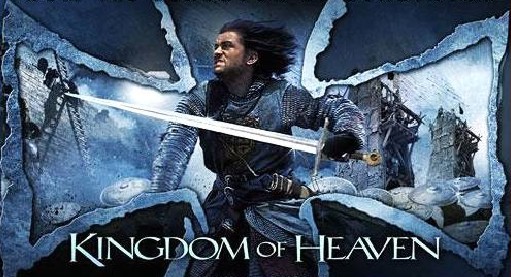KINGDOM OF HEAVEN

Balian is a French
farrier who lives alone without a family because his wife has committed suicide
after the death of their young son. However, he receives a visit from Godfrey
of Ibelin. Godfrey is a noble crusader, who says he is Balian’s father and
wants to take Balian to the Holy Land. Balian accepts the offer and embarks on
a journey to Jerusalem with his father and a company of knights. Godfrey was mortally wounded in battle, and
at this point Balian had to face the difficult life of defending himself on the road to the Holy City
traversed by pilgrims of all faiths. At King Baldwin’s court, the Frenchman
meets important characters and figures from Jerusalem. Following a conspiracy
hatched by the city’s high dignitaries, Balian will have to face the Saracen
army led by Saladin, to avoid the conquest of Jerusalem by the Muslims.
The period taken in consideration is
the period of peace between the second and third crusades. Period set precisely
under the sign of Baldwin, on the one hand, and Saladin on the other. I believe that this
movie correctly represents the middle ages, in particular the period of the
crusades (12/13th century) and can be helpful to understand the historical
context and what being a defender of Christianity means.
At first, I would say that this movie provides a non-offensive, but
rather complex and conciliatory image of an Islamic leader, Sultan Saladin.
This way of presenting Saladin in a good way may differ from the documents of
the past or even previous movies describing this period. For example, Saladin
shows mercy when tells Balian that he only wants Jerusalem, he doesn’t want the
life of the people that live inside. Balian is surprised. Indeed, when the
Templars took Jerusalem they
slaughtered all the Muslims
inside the city. Saladin then says, “I’m not a man of that kind”. In this case
Saladin is described as merciful and without the desire for revenge. Balian
then says, “If God cares so much about this city, he will know how to deal with
it” and leaves the city to the King. Here someone could question the way in
which Balian decides to leave the city to the Muslims, but the reality is that
a Christian hero is willing to abandon Jerusalem to save the lives of thousands
of innocent people. The other side represents a Muslim hero that attacks
Christians only when it is provoked by the senseless cruelty.
Obviously, Christianity in this movie is one of the central themes, and
we can see it when Balian is besieged by a coward bishop. At some point Balian,
during the conflict says, “repent to Islam, then Repent!” and again “not for
these walls but for the people inside”. Again, in another scene of the movie he
says “we do not fight for the tombs, for the mosques, for the crosses, for
anyone in the past who has made this city a symbol; we fight for the people,
for the women, for the old, for the children; we fight for our life. This
exaltation of Christianity perfectly represents the values and the ferocity
combined with just war theory of the defender of the Christianity.
Finally, I believe the message is that faith is also in the most humble
minds, or in those who believed they had lost it permanently. Sometimes it just
lacks in those who should be their spokespersons (for example the figure of the
bishop who thinks only about his own salvation).



You mentioned that we see King Baldwin’s court and that the main character is given the sign of Baldwin to carry in one hand in his dealing with Saladin. I was wondering if we ever get to see King Baldwin? Baldwin IV of Jerusalem was known as the “leper king” since he had leprosy. As the story goes, he either wore a mask or heavy makeup to hide his deformed face. I was just curious as to whether they included this in the film or not.
ReplyDeletewe do get to see Baldwin IV! As you said, we see him wearing a mask to hide his deformed face because he had leprosy. We also see him without the mask whenever he dies.
DeleteThe movie sounds very interesting. You made some good points.
ReplyDeleteIt surprised me how vile the Christians were to the Muslims back then.
ReplyDeleteI watched this movie a while back, and honestly I loved it. I loved that it let its characters be more complex, and wasn't just cardboard cutout good guy bad guy movie. It handled the corruption of those who were supposed to be good and the good character of those who were supposed to be bad by the Church's standards well in my opinion.
ReplyDeleteInteresting point you made about the Sultan being portrayed as kind. I guess we never notice them as always being portrayed as evil until we see them portrayed as kind.
ReplyDelete